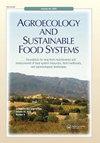什么进去了,什么出来了:再生农业实践的范围审查
IF 2.6
3区 农林科学
Q1 AGRICULTURE, MULTIDISCIPLINARY
引用次数: 0
摘要
这一范围审查审查了同行评审和灰色文献,以探索“无到低的外部投入”声明对再生农业意味着什么。确定了五种有机改良投入(堆肥提取物、粪便、地膜、生物炭、粮食系统废弃物)和四种土地管理过程(牲畜管理和整合、作物多样性、减少耕作、综合方法)。研究结果包括由取代外部投入(如合成肥料)的过程产生的“无到低外部投入”模型。有机改良投入和再生土地管理过程促进了土壤、农场和景观尺度上的生物和养分循环。再生农业与其他耕作方式重叠,包括与生态农业和保护性农业相关的耕作方式。本文章由计算机程序翻译,如有差异,请以英文原文为准。
What goes in and what comes out: a scoping review of regenerative agricultural practices
This scoping review examined peer-reviewed and gray literature to explore what a “no-to-low external input” statement means for regenerative agriculture. Five organic amendment inputs (compost extract, manure, mulch, biochar, food systems waste) and four land management processes (livestock management and integration, crop diversity, tillage reduction, comprehensive approach) were identified. Findings include “no-to-low external input” models arising from processes which function to displace external inputs (e.g., synthetic fertilizer). Organic amendment inputs and regenerative land management processes promote biology and improve nutrient cycling at soil, farm, and landscape scales. Regenerative agriculture overlaps with other farming practices including those associated with agroecology and conservation agriculture.
求助全文
通过发布文献求助,成功后即可免费获取论文全文。
去求助
来源期刊

Agroecology and Sustainable Food Systems
AGRICULTURE, MULTIDISCIPLINARY-GREEN & SUSTAINABLE SCIENCE & TECHNOLOGY
CiteScore
4.80
自引率
7.70%
发文量
73
期刊介绍:
Agroecology and Sustainable Food Systems is devoted to the rapidly emerging fields of agroecology and food system sustainability. By linking scientific inquiry and productive practice with transformative social action, agroecology provides a foundation for developing the alternative food systems of the future. The journal focuses on the changes that need to occur in the design and management of our food systems in order to balance natural resource use and environmental protection with the needs of production, economic viability, food security, and the social well-being of all people.
Agroecology and Sustainable Food Systems examines our current food systems from production to consumption, and the urgent need to transition to long-term sustainability. The journal promotes the study and application of agroecology for developing alternatives to the complex problems of resource depletion, environmental degradation, a narrowing of agrobiodiversity, continued world hunger, consolidation and industrialization of the food system, climate change, and the loss of farm land. The journal uses a food systems approach, and seeks experiences in agroecology that are on-farm, participatory, change-oriented, and backed by broad-based methodologies of sustainability analysis and evaluation.
 求助内容:
求助内容: 应助结果提醒方式:
应助结果提醒方式:


